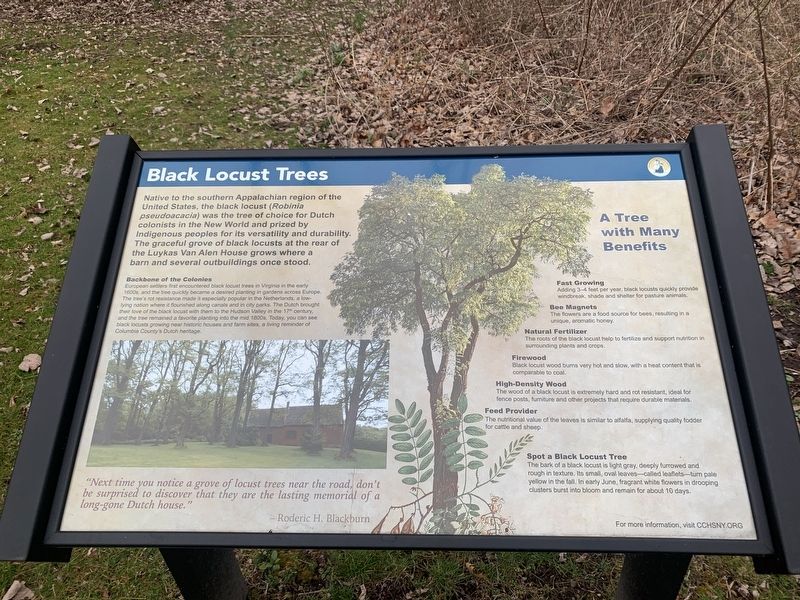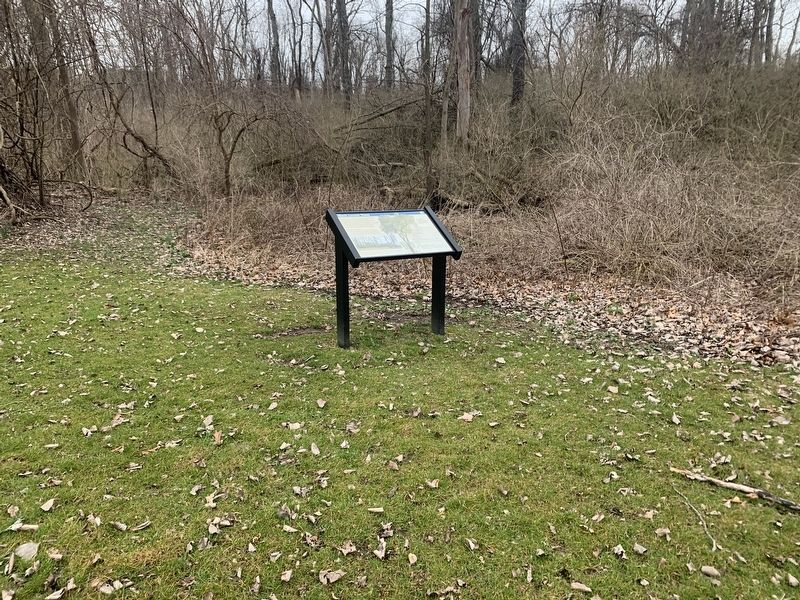Near Kinderhook in Columbia County, New York — The American Northeast (Mid-Atlantic)
Black Locust Trees
A Tree With Many Benefits
Native to the southern Appalachian region of the United States, the black locust (Robinia. pseudoacacia) was the tree of choice for Dutch colonists in the New World and prized by Indigenous peoples for its versatility and durability. The graceful grove of black locusts at the rear of the Luykas Van Alen House grows where a barn and several outbuildings once stood.
Backbone of the Colonies
European settlers first encountered black locust trees in Virginia in the early 1600s and the bed quickly became a desired planting in gardens across Europe. The tree’s rot resistance made it especially popular in the Netherlands, a low-lying nation where it flourished along canals and city parks. The Dutch brought their love of the black locust along with them to the Hudson Valley in the 17th century, and the tree remained a favorite planting into the mid 1800s. Today, you can find black growing near historic houses and farm sites a living reminder of Columbia County's Dutch heritage.
"Next time you notice a grove of locust trees near the road, don't be surprised to discover that they are the lasting memorial of a long-gone Dutch house." - Roderic H. Blackburn
Fast Growing Adding 3-4 feet per year, black locusts quickly provide windbreak, shade and shelter for pasture animals.
Bee Magnets
The flowers are a food source for bees, engin unique, aromatic honey.
Natural Fertilizer
The roots of the black locust help to fertilize and support nutrition in surrounding plants and crop
Firewood
Black locust wood bums very hot and slow, with a heat content that is comparable to coal.
High-Density Wood The wood of a black locust is extremely hard and rot resistant, ideal for fence posts, furniture and other projects that require durable materials.
Feed Provider
The nutritional value of the leaves is similar to alfalfa, supplying quality fodder for cattle and sheep
Spot a Black Locust Tree
The bark of a black locust is light gray, deeply furrowed and rough in texture. Its small, oval leaves - called leaflets - turn pale yellow in the fall. In early June, fragrant white flowers in drooping clusters burst into bloom and remain for about 10 days.
For more information, visit CCHSNY.ORG
Erected by Columbia County Historical Society.
Topics. This historical marker is listed in these topic lists: Agriculture • Colonial Era • Horticulture & Forestry.
Location. 42° 22.852′ N, 73° 41.526′ W. Marker is near Kinderhook, New York, in Columbia County. Marker can be reached from New York State Route 9H, 0.2 miles north of Fischer Road, on the right when traveling south. Marker can be reached on foot from Ichabod Crane Schoolhouse parking lot. Touch for map. Marker is at or near this postal address: 2589 NY-9H, Kinderhook NY 12106, United States of America. Touch for directions.
Other nearby markers. At least 8 other markers are within walking distance of this marker. Native Inhabitants (a few steps from this marker); Washington Irving (within shouting distance of this marker); Enslavement In The Hudson Valley (within shouting distance of this marker); Immigrant Farmers (within shouting distance of this marker); Early Dutch Settlers (about 300 feet away, measured in a direct line); Colonial Dutch Houses (1690-1750) (about 300 feet away); Eleanor Roosevelt at Ichabod Crane (about 300 feet away); One-Room Schoolhouses (about 400 feet away). Touch for a list and map of all markers in Kinderhook.
More about this marker. Marker is the seventh on the Ichabod Crane Schoolhouse Trail.
Also see . . . Black Locust (Wikipedia). (Submitted on April 10, 2024, by Steve Stoessel of Niskayuna, New York.)
Credits. This page was last revised on April 18, 2024. It was originally submitted on April 9, 2024, by Steve Stoessel of Niskayuna, New York. This page has been viewed 49 times since then. Photos: 1, 2. submitted on April 9, 2024, by Steve Stoessel of Niskayuna, New York. • Michael Herrick was the editor who published this page.

